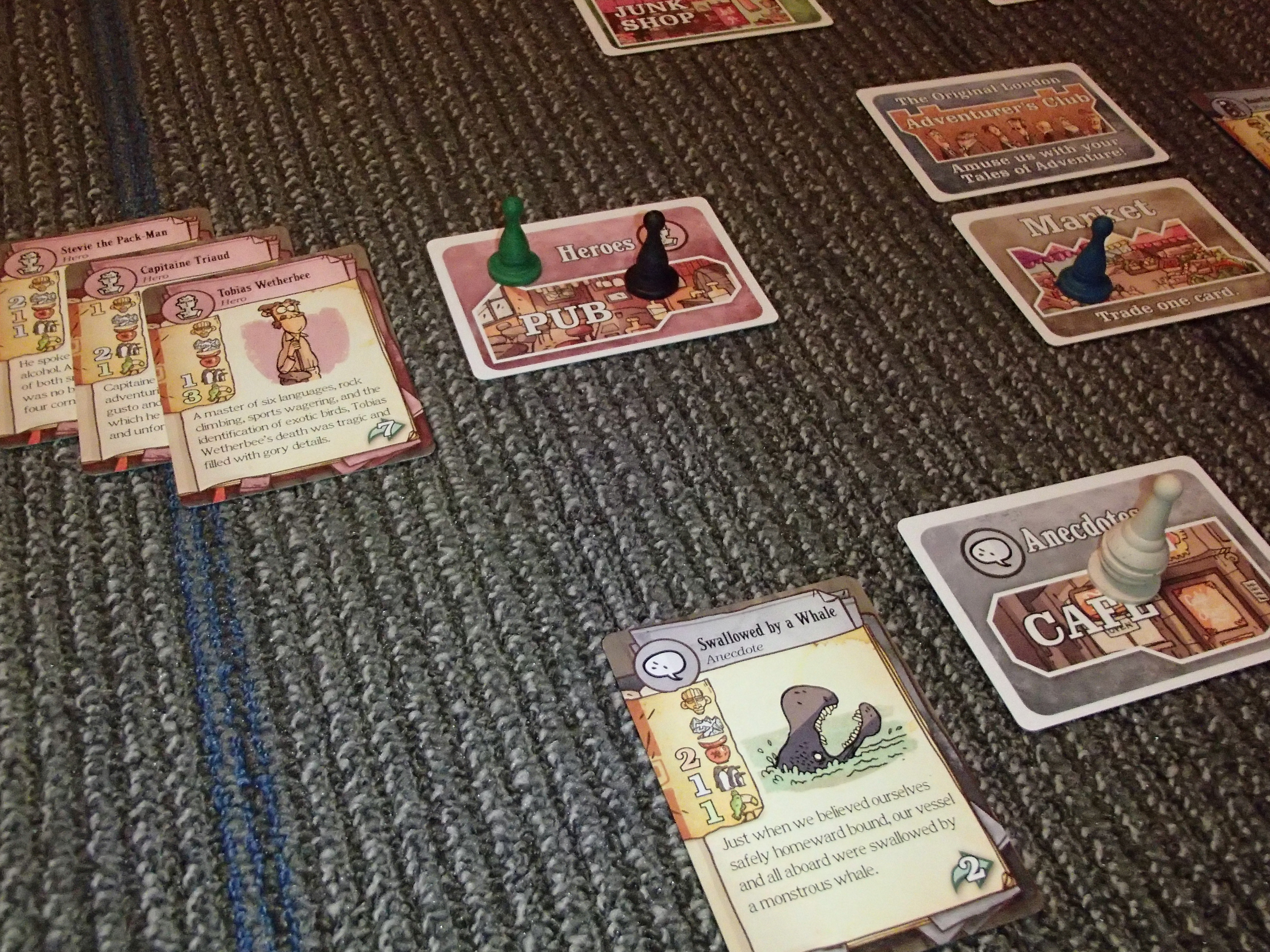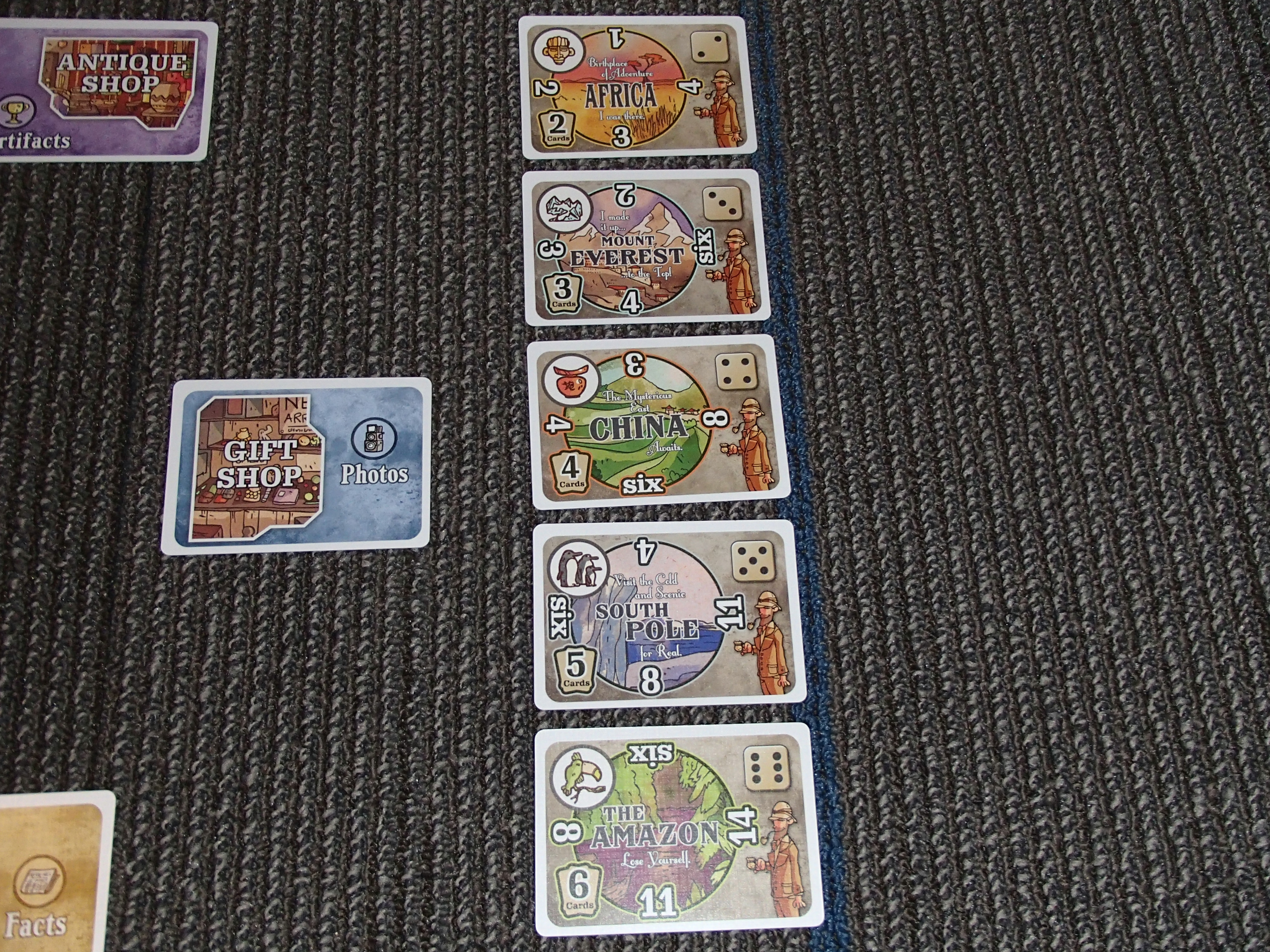| Publisher | Cheapass Games |
| Design Credit | James Ernest |
| Art Credit | Harold Fay |
| Editing Credits | Mike Selinker, Carol Monoghan |
| Game Contents | 84 adventure cards, eight map cards, five Bonus cards, three player reference cards, six player pawns, one Professor Elemental pawn, one six-sided die |
| Guidelines | Faux globe-trotting travelogue card game |
| MSRP | $25 |
| Reviewer | Andy Vetromile |
As the company’s name might suggest, Cheapass Games (in the personage of James Ernest) leaves nothing on the table when it comes to designing games, up to and including reusing previously released games. Not one to sit on his laurels, though, turning Capt. Park’s Imaginary Polar Expedition into Stuff and Nonsense required pretty much reimagining the imaginary into a whole other set of mechanics.
If you’ve never heard of chap-hop artist Professor Elemental, he’s the author of a popular series of web videos that tap into every Anglophile’s longing to be British or at least see British people doing relentlessly British things. (He does several minutes on tea done right.) Well, Captain Park has been retired and the mantle of his great idea has passed on to the good Professor. Park was in the habit of disappearing for months at a time, collecting odds and ends from the odd ends of the Earth, and reappearing at his Adventurers’ Club to entertain his fellows with wild tales of his itinerant antics. Thing is, he never left London. He scoured Shops to collect “proof” of his travels and then spun a yarn that kept people in suspense (and him in free drinks and book deals).
Two to six other people like the sound of this deceit and have decided to pursue the same scheme. Of course, the progenitor (or if you prefer, inheritor) of this clever moneymaker does not like the idea of competition, so all Elemental has to do to discredit his rivals is to find them and reveal they’re in London. Players move about the board – which is itself composed of cards – gathering more cards that tell a good story. Each location offers a different kind of card so if you want a Hero for your tale go to the Pub, for example, while Anecdotes are overheard at the Café. These Shops form a ring with the Market and Adventurers’ Club in the middle. Professor Elemental haunts the outer ring, trying to catch his foes as they shop so he can drain them of cards or points. When a player feels he has sufficient evidence of his phantom trip he goes to the Club to expound on his findings.
Each card presented represents some facet of the player’s fairy story they were able to dredge up some flimsy evidence for, and each is rated for the number of points it scores for different locations. For example, the Specimen card Exotic Tea gets points for telling a story about Africa, China, or the Amazon, but not Mount Everest or the South Pole (who’s going to believe there’s a decent cuppa to be made in Antarctica?). The locales themselves offer bonus points (hence why they’re called Bonus cards), but the first person there gets the best addition to their score. Successive tales about the same place get old (who’s going to believe there’s more than one decent story to be told about Antarctica?) and score fewer points.

"Grab a hero and let's get out of the pub before Professor Elemental nails us" is probably not a sentence you thought you'd hear when you woke up this morning
Players continue collecting and “reminiscing” (and ducking to avoid the Professor) until someone achieves a preset number of points. His illusory travel itinerary outdoes Elemental, wins the game, and makes a most powerful enemy . . .
Whereas the original set was only several cards and printed sectional boards (the name of the company is Cheapass, remember?), Stuff and Nonsense provides the whole enchilada. There’s a pawn for each player and the Professor himself; a die to determine which destination’s stories are in vogue; and a better set of hilarious, full-color cards, giving you a quality set of nonetheless inexpensive components that condense the original rules into their new expression. You can play up to eight players though they recommend keeping it at six or fewer (and someone needs to cough up two more pawns for the added participants). For all that, the new and still-snug box hasn’t even grown much in size and fits better in a pocket.
And that revised look is just part of the win here. Stuff and Nonsense is proof that a second pass at something is the better version of it. From the clever title to the game play, the team responsible has upped their game (pun unintended). The board was already pretty abstract, so turning it into a circle of cards with a couple locations in the middle is simpler, is visually more appealing, and allows a little more randomness in the layout. Bonus points from locations are kept by rotating them so a new value is “upright” on the card – hardly elegant, but better than the tiny spaces (and tinier counters) on the printed sheet from days gone by. The only thing without improvement appears to be the scoring system, which still asks the players bring pencil and paper.
Professor Elemental should play a slightly bigger role in vexing players. Sometimes he’s almost stagnant, other times he’s pretty motivated, and overall it wouldn’t have hurt to have ramped the threat level up a bit, but at least no one is crippled every turn from one bad move. (How they convinced the fellow to lend his name to this delightful enterprise is a story everyone at the Club wants to hear.) Play is quick, strategies are plentiful but obvious (all the info you need to make good, or bad, choices is there at a glance), and everyone is continuously fearful the others are thiiis close to bursting through the doors of the Club ahead of them with their better, glorious, more profitable tale. Games play in less than an hour. If you’ve explored it before the clean new look is going to be a revelation, and whether you’ve trod this ground previously or not, Stuff and Nonsense is fun, easy, and intuitive.


